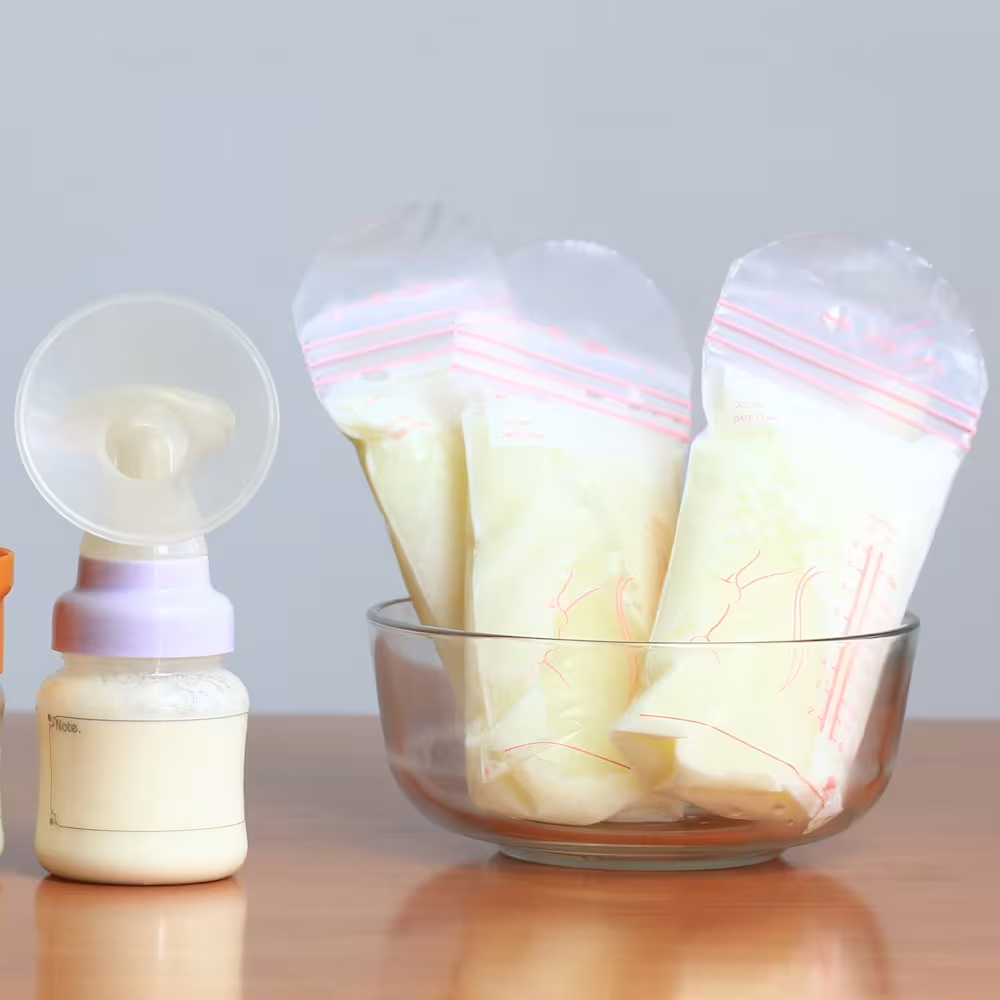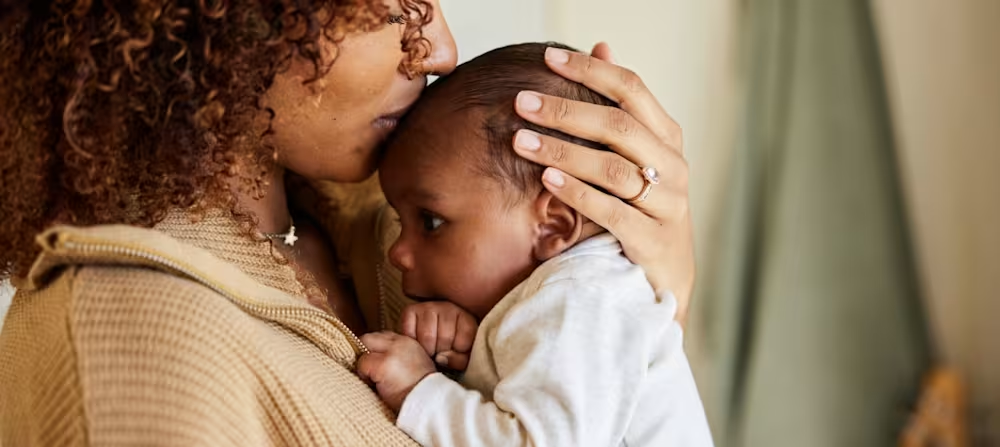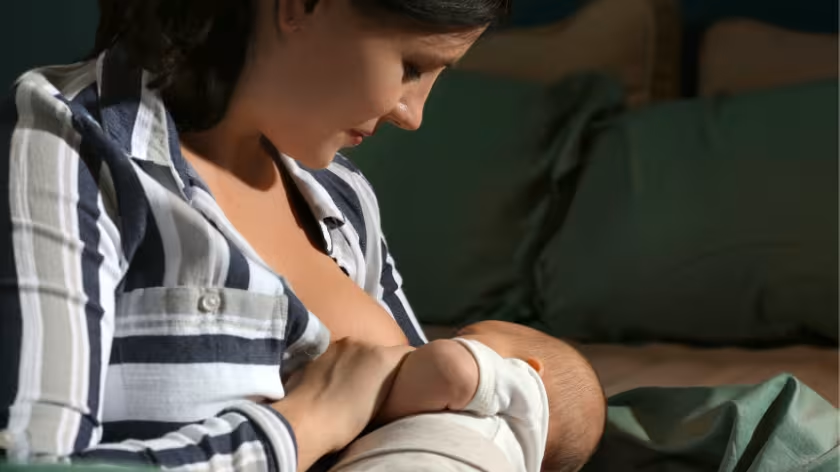Sore nipples from breastfeeding? Expert tips for relief
Updated Oct 17, 2025

Breastfeeding isn’t always easy, or pain-free, especially in the beginning. It may take time to feel like you’re getting the hang of it and it’s completely normal to experience some nipple soreness during this time as your body adjusts. But the good news is that nipple pain or sensitivity shouldn’t last beyond the first week or two.
However, if you continue to experience nipple discomfort or a sudden onset of new nipple pain, it may indicate an underlying issue. Either way, there are things you can try to soothe stinging nipples — and help improve what’s causing it.
Table of Contents
Nipple challenges explained
Although breastfeeding isn’t always comfortable, especially in the beginning, it also shouldn’t hurt. Some “mild” tenderness or sensitivity is common for the first two weeks of breastfeeding [] as your nipples adjust, and then it should go away. And the skin on your nipple shouldn’t break down any easier than skin elsewhere on your body.
But once your baby is latching well, breastfeeding shouldn’t hurt []. However, pain may accompany a variety of different nipple challenges we'll outline below. If breastfeeding is painful beyond initial tenderness or you have any questions about your nipple pain, check in with a lactation consultant or medical provider.
| Nipple challenge | Description | Common causes | Self-care tips |
|---|---|---|---|
| Sore nipples | General discomfort or pain in nipples | Poor latch, ineffective sucking, pumping problems, dry skin | Apply nipple cream, hydrate nipples, correct latch, rest, check pump |
| Cracked nipples (fissure) | Raw, cracked skin, potentially bleeding nipples | Dry skin, trauma from improper latch or pump flange size | Use nipple shields, gentle cleansing, hydrate nipples, coconut oil or lanolin, check pump flange fit |
| Milk bleb or blister | Small white, yellow, or clear dot on nipple | Inflammation in milk ducts | Check baby’s latch/positioning, treat any clogged ducts, ask your healthcare provider about sunflower lecithin supplements |
| Nipple blister | Fluid-filled blister | Skin trauma from friction (incorrect latch, wrong flange size or position, etc). | Check baby’s latch/positioning, have lactation consultant confirm your flange size and pump technique |
| Nipple vasospasms | Intense nipple pain; nipples look creased, blanched, or go from white to red during/after breastfeeding | Associated with Reynaud’s phenomenon, a bad latch, and cold temperatures | Check your baby’s latch, keep your nipple warm (and avoid exposing it to cold air), ask a lactation consultant or doctor |
| Thrush | Red, irritated, burning nipples and possibly white patches in baby’s mouth or bright red diaper rash | A yeast infection | Anti-fungal medication, speak to a medical provider |
| Mastitis | Flu-like symptoms; breast feels hot to the touch, redness, pain, and lump in breast | Breast inflammation from a clogged duct, that may turn into an infection | Continue breastfeeding, pain relievers, ice, thoroughly drain breast, antibiotics, speak to a medical provider |
| Inverted nipples | Nipples that lay flat or point inward | 10 - 20% of women are born with an inverted nipple | Ask a lactation consultant for latch/breastfeeding tips, consider a nipple shield |
Sore nipples
It’s common to experience nipple sensitivity when you first start nursing after your baby is born. At times, your nipples may feel irritated or inflamed during your breastfeeding journey, which can happen for various reasons.If there’s any damage to the nipple tissue, you may feel nipple soreness during or after nursing.
Milk bleb or blister
A milk bleb looks like a small dot or pimple on the surface of your nipple or areola. These little bumps can be white, yellow, or clear and it’s possible to have multiple milk blebs on one or both of your nipples. Milk blebs [] aren’t dangerous but are often painful (especially while nursing). They indicate inflammation in your milk ducts and may cause sharp nipple discomfort as well as shooting pain deep in your breast.
Although these bumps are often called milk blisters, they aren’t the same as a blister caused by friction []. (See below.)
Nipple blister
A blister on your nipple is different from a milk blister or bleb. Unlike milk blisters, friction causes this type of blister (e.g. an improper latch or flange size) and it may be filled with fluid or blood.
Cracked nipples (fissure)
Sometimes painful cracks, also known as nipple fissures, develop on one or both nipples. With a fissure, your nipple may feel raw, chafed, dry, irritated, itchy, or sore. Although nipple fissures are most common when someone is breastfeeding [], they can also happen with friction during exercise or skin conditions (even if you aren’t lactating). If left untreated, cracked nipples can bleed, become infected, and lead to an abscess or mastitis.
Nipple vasospasm
A nipple vasospasm is associated with Raynaud’s phenomenon [] and happens when your blood vessels constrict, temporarily reducing blood flow to your nipple. As a result, your nipple blanches and may also go from white to blue or red before returning to normal as circulation resumes. These episodes of color change are often very painful and may happen during or after a breastfeeding session.
Reduced circulation from the cold or a bad latch compressing your nipple (you may notice your nipple looks creased or misshapen after nursing), may exacerbate nipple vasospasms. Not everyone who experiences nipple vasospasms will have the more frequent and painful episodes associated with Raynaud’s. Raynaud’s phenomenon is not harmful in any way and typically resolves on its own once triggers are removed (e.g. sudden changes in body temperature or compression of tissue resulting in poor circulation.)
Thrush or mastitis (fungal or bacterial infections)
If your nipple starts itching, flaking, burning, or is cracked and bright pink or red, you may have thrush (a fungal yeast infection) []. You may also notice white spots in your baby’s mouth that indicate thrush. You may also experience a shooting pain in your breast. The fungus (Candida albicans) is naturally present in our bodies but it likes dark and most environments. It may turn into an infection if you have cracked or damaged nipples, or if there’s an overgrowth []. Common causes of an imbalance include antibiotics, contraceptive pills, and stress. It is important to note that thrush can be present even if only you or your baby has symptoms — thrush can also be passed back-and-forth from you and baby.
Nipple discomfort and deep breast pain could also indicate mastitis [] (breast tissue infection or inflammation). However, symptoms of mastitis also include fever, chills, a breast lump or swelling, red splotches or a wedge shape across your breast, and breast warmth.
Inverted or flat nipples
Instead of pointing out, inverted nipples are flat or point inward. This nipple shape may make it harder for baby to latch, making breastfeeding more challenging. People are typically born with inverted or flat nipples and they’re usually harmless []. An estimated 10 - 20% of females [] are born with one or two inverted nipples. However, if your nipples suddenly invert, it could indicate a health concern.
What causes sore nipples with breastfeeding?
After the initial adjustment period of up to two weeks, breastfeeding shouldn’t be painful. If you continue to have sore nipples, both physical and behavioral factors may contribute to the nipple challenges and discomfort. Causes of sore nipples can include:
| Structural variation in baby’s mouth (e.g. lip or tongue tie) |
| Pumping problems (e.g. incorrect setting or technique) |
| Pump flange issues (e.g. wrong size or placement) |
| Skin sensitivity (e.g. dry, irritated, chaffed skin) |
| Bacterial overgrowth |
| Oversupply |
| Removing baby from the breast without breaking the suction first |
| Using harsh or drying products on your nipples |
| Clogged ducts (leading to milk blebs or mastitis) |
| Breastfeeding baby with thrush without treatment |
Self-care tips to heal sore nipples
If you experience nipple discomfort at some point during your breastfeeding journey, there are some at-home tips to help with the pain and encourage healing. Keep in mind that depending on the cause of your nipple pain, certain things can exacerbate it and it may be best to avoid them.
Dos
To help soothe sore nipples [] and encourage healing, consider:
Keeping your nipples hydrated with lanolin cream or your own breast milk (you can express a little onto your nipples after feedings or pumping)
Only using mild soap and water to clean your breasts
Wearing a loose-fitting bra and clothes
Change out nursing pads often with fresh, clean ones
Changing nursing positions each time you breastfeed (e.g. cradle, football, cross-cradle)
Other things to try include:
Putting coconut oil on your nipples
Getting help early if your nipples are cracked or bleeding (this increases your risk of getting an infection) []
Start nursing on the more comfortable side [] until your letdown and then immediately switch to the other breast (babies suck most aggressively before milk begins to flow)
Using ice to help with any inflammation
Taking ibuprofen and/or acetaminophen to help with swelling
Consider taking sunflower lecithin [] (which reduces the risk of clogged ducts); consult with your healthcare provider regarding proper dosage
Try silver nursing cups, breast shells, or nipple shields (we'll explain more below)
Reach out to your doctor or lactation consultant with any questions
The effectiveness of these tips depends on the cause of your nipple pain. For example, these suggestions won’t fix latch problems or treat an infection, and you should always speak to a medical provider or lactation consultant about any questions or prolonged pain.
Don’ts
To start feeling better as soon as possible, there are certain things you may want to avoid. While dealing with nipple pain, don’t:
Wait too long to seek help
Try to pick or pop milk blebs [](consult with a lactation consultant)
Continue pumping through pain without checking pump settings and flange size/placement
Use heat (it may make things worse by increasing blood flow and inflammation) []
Use harsh soaps or chemicals that could dry out your nipples (and lead to cracking)
Put lanolin or expressed breast milk on your nipples if you have a yeast infection []
Limit the length of nursing sessions as a way of trying to avoid sore nipples
Is it safe to continue breastfeeding if my nipples are bleeding?
If your nipples are cracked or bleeding, it’s important to determine what’s causing it so that you can fix it and reduce your risk of infection []. While you figure out the source of the nipple damage (e.g. harsh products, tongue tie, pump friction), continue to breastfeed as normal. Not only is it safe to breastfeed if your nipples are bleeding, it’s encouraged in order to maintain your supply. However, if breastfeeding becomes too painful while your nipples are damaged, reach out to your doctor or lactation consultant for advice on preserving your supply and ensuring your baby’s feeding needs are met.
If you're pumping, you may notice blood in your breast milk, often known as strawberry milk []. Although this pink color change may seem alarming, it’s still safe for little ones to drink []. Keep in mind that cracked nipples aren’t the only reason why you may find blood in your breast milk — other potential causes include Rusty Pipe Syndrome (a rare, self-limiting benign condition) []. It’s important to identify the source of your bleeding, but you can continue pumping while you do. Don’t hesitate to reach out to your healthcare provider or lactation consultant with any questions and for treatment options.
Can nipple pain affect my milk supply?
Nipple discomfort doesn’t directly cause an immediate drop in supply. However, prolonged nipple discomfort may indirectly affect your milk supply. If you’re dealing with sore nipples, the pain may negatively impact your breast milk production if it:
Causes you to limit the length of nursing sessions
Leads to you avoiding nursing sessions altogether
Makes breastfeeding stressful — stress can interfere with your milk letdown [], eventually contributing to reduced milk production []
Keep in mind that for the first 6 weeks, a breastfeeding parent should expect a newborn to have at least 4 - 6 wet diapers per 24 hours as well as a few poops. If you notice your baby isn't producing this many wet or dirty diapers, check in with their doctor to ensure they're getting sufficient nutrients.
How long does it take for sore nipples to heal?
How long it takes for a sore nipple to heal depends on the cause and severity of the issue. For example, an infected milk bleb will likely take longer to heal than irritated skin that started chaffing from a misplaced pump flange.
Some nipple pain may resolve shortly after a breastfeeding or pumping session, while others might find relief only after discovering the cause of their discomfort and treating it. For more serious causes, including infection or latch difficulties, it may take days or weeks to resolve the problem and then physically recover from it. Hydrogel pads and silver nursing cups can speed along healing for many types of nipple damage. However, at any point, if you’re experiencing nipple pain and are concerned, contact your doctor or a lactation consultant.
Nipple shields: Are they helpful for sore nipples?
Nipple shields may be the difference between ending a breastfeeding journey before a desired timeline and being able to continue nursing. Nipple shields may allow time to work through breastfeeding issues (like correcting a baby’s latch or having a tongue tie released) and give damaged nipples the opportunity to heal. Then, once things have improved, she can return to nursing without the nipple shield if desired.
Nipple shields are often misunderstood or confused with other breastfeeding gear, including breast shells. Like nipple shields, breast shells are intended to aid nursing and may be another valuable tool to help protect sore nipples — and hopefully make breastfeeding a bit less painful.
There are three main types of breast shells:
For sore or cracked nipples
These breast shells are protective domes that sit in your bra and encourage airflow while preventing anything from touching the face of your nipple. This type of breast cover aids in healing because it helps protect sore or cracked nipples from material rubbing against them and promotes air circulation.
For inverted nipples
This type of breast shell isn’t intended to help heal cracked nipples. Instead of having an area that goes around the areola or air pockets for circulation, this style of breast shell is much smaller with an opening just large enough for the nipple. It’s designed to add shape and length to help flat or inverted nipples, making them more conducive for nursing. Breast shells for flat nipples also make latching easier for babies in the meantime. They work by putting pressure directly at the nipple and encouraging the tissue to point outwards.
For collecting milk
These breast shells or “collection cups” are designed to catch breast milk. While breastfeeding, the collection cup can be placed over the breast you are not feeding from to passively collect milk from the other side. You can also wear one on each breast throughout the day to help with spontaneous leaking.
How can I prevent nipple soreness and bleeding while breastfeeding?
It’s not always possible to prevent sore nipples, especially if you’re just starting your breastfeeding journey. But there are some ways to help minimize the risk:
When pumping:
Get fitted for the correct flange size (and remember that your size can change over time)
Check your flange placement during every pumping session
Be mindful of pump settings (vacuum setting too high etc.)
Try lubricating pumping oil or spray
When breastfeeding:
Be mindful when removing baby from your breast. Gently break the suction [] first by slipping your finger into the side of your baby's mouth
Alternate breastfeeding positions to ensure milk is thoroughly draining
Check with a lactation consultant if you have any questions about your baby’s latch
When breastfeeding or pumping:
Try silver nursing cups to help prevent friction or chaffing
Keep your skin well hydrated and your nipples clean
Always listen to your body
When to seek professional advice
Breast soreness and nipple sensitivity are expected as your nipples adjust to your newborn’s sucking. However, breastfeeding shouldn’t be painful after your baby is well-latched []. If you have cracked or damaged nipple skin or pain that’s not improving after the first 1 - 2 weeks of breastfeeding, check in with a lactation consultant.
Nipple discomfort can also happen at any point in your breastfeeding journey, and this may indicate an underlying issue, including a clogged milk duct, an improper latch, a bacterial infection, or a fungal infection. Always mention any concerns to your medical provider, especially if you experience nipple pain with:
A fever
Chills or flu-like symptoms
Red streaks or patch on your breast
Shooting or burning breast pain during or after feedings
Deep breast pain or pain that doesn’t get better after your baby is properly latched
Previously pain-free nipples are now cracked, itchy, burning, red, shiny, flaky, rashy, or blistery (this may indicate a thrush infection) []
Takeaway
It’s normal to experience some nipple tenderness and sensitivity when you first start breastfeeding or pumping as your nipple adjusts. However, the pain should improve within the first 1 - 2 weeks if your baby is well-latched.
Prolonged nipple pain or discomfort beyond these first initial days, without improvement, may be a sign of an underlying problem. After breastfeeding is established, new nipple discomfort may also indicate an issue.
There are different types of nipple challenges during breastfeeding that can lead to pain including inverted nipples, cracked nipples, milk bleb or blisters, nipple vasospasms, mastitis, and thrush.
Both behavioral and physical factors can contribute to sore nipples, including an improper latch, structural variations in baby’s mouth, pumping problems, using the wrong flange size, an oversupply, using harsh or dehydrating products on your skin, and removing baby from the breast without first gently breaking the seal between their mouth and your skin.
It’s safe to continue breastfeeding if your nipples are bleeding or there’s blood in your breast milk. If left untreated, prolonged nipple pain can indirectly affect your milk supply — especially if it causes you to alter your nursing or pumping routine.
Depending on what’s causing the nipple damage, it may take a couple of days or weeks for sore nipples to heal once you identify the problem and correct it. Don’t hesitate to reach out to a healthcare provider or lactation consultant for help.
Nipple shields, breast shells, and silver nursing cups are tools that may be useful for breastfeeding nipple challenges.
Contact a healthcare professional or lactation consultant with questions anytime. Consider checking in, especially if you still have discomfort after the first two weeks of breastfeeding, or if you have a new onset of nipple pain that doesn’t improve. Keep in mind that if your nipples are cracked or bleeding, there’s an increased risk of infection and it’s beneficial to seek help sooner than later.
Sore and bleeding nipples while breastfeeding FAQs
Share article:
Note: The content on this site is for informational purposes only and should not replace medical advice from your doctor, pediatrician, or medical professional. If you have questions or concerns, you should contact a medical professional.
21 Sources
Table of Contents
Share article:





